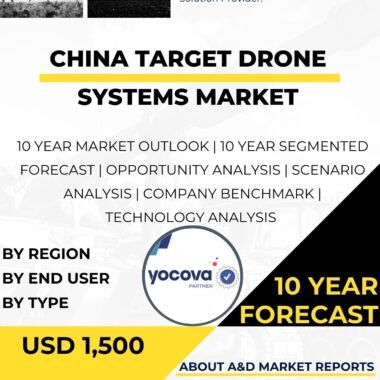Description
Target drone systems are a critical component of modern military training and testing programs. These unmanned aerial vehicles (UAVs) serve as simulated targets for training air defense units, testing weapon systems, and evaluating the effectiveness of various military equipment. In Canada, target drone systems play a significant role in enhancing the Canadian Armed Forces’ (CAF) readiness and operational capabilities. This article explores the importance of target drone systems in Canada, their history, types, technology, and their contributions to military training and development.
The use of target drone systems in Canada can be traced back to the mid-20th century when the Canadian military recognized the need for realistic and cost-effective training scenarios. Target drones were employed to mimic enemy aircraft or missiles, providing air defense units with challenging and dynamic exercises. These early target drones were primarily converted manned aircraft modified for remote control operation.
As technology advanced, dedicated target drone systems were developed to meet the growing demands of military training and testing. These systems offered greater versatility, increased flight endurance, and the ability to simulate a wider range of threat scenarios. The CAF embraced these developments and expanded its target drone capabilities to encompass various operational domains.
One of the key advantages of target drone systems lies in their ability to simulate realistic threats without endangering human pilots. The use of UAVs as targets allows air defense units to practice engagements against adversary-like aircraft and missiles in a safe and controlled environment. This enhances their proficiency and confidence in dealing with potential threats during real-world operations.
Canada’s target drone systems come in various forms, catering to different training and testing requirements. Airborne target drones are one of the most commonly used types. These UAVs are launched from the ground or air and are equipped with sophisticated control systems to replicate the flight characteristics of manned aircraft or missiles accurately.
Surface target drones, also known as sea-skimming drones, simulate incoming anti-ship missiles. These drones fly at low altitudes above the water, replicating the trajectory and speed of sea-skimming missiles, challenging naval vessels to engage them effectively.
Ground-based target drones provide land-based units with training scenarios simulating incoming artillery shells, mortar rounds, or other surface threats. These drones allow ground forces to practice their responses to various indirect fire threats, enhancing their ability to protect personnel and assets during actual combat situations.
Subscale target drones are another specialized type employed for testing and evaluating air defense systems. These drones are designed to be smaller and less expensive than full-sized aircraft, making them ideal for testing and experimentation without the associated costs and risks of using operational aircraft.
The technology that drives target drone systems has evolved significantly over the years. Advancements in materials, propulsion, and avionics have led to more capable and sophisticated drones. These improvements translate to better flight performance, increased endurance, and the ability to simulate a broader range of threats accurately.
Modern target drone systems are equipped with advanced control systems that allow for autonomous or remotely piloted flight. Some drones are even capable of performing complex pre-programmed flight profiles or being controlled in real-time by operators on the ground. These capabilities enable target drones to execute realistic and challenging maneuvers during training and testing exercises.
In addition to their role in military training, target drone systems also serve as an essential tool for evaluating the effectiveness of new weapons and military equipment. Before integrating new systems into the CAF’s operational arsenal, they undergo extensive testing against target drones to assess their performance and suitability for specific missions.
Canada’s target drone systems are often deployed during military exercises and training events conducted domestically and with allied nations. These joint training opportunities foster interoperability among different forces and improve the overall readiness and coordination of the CAF in multinational operations.
The CAF places a strong emphasis on safety and risk management when operating target drone systems. Strict safety protocols and procedures are followed during target drone operations to minimize the potential for accidents or incidents. Additionally, target drone operators and support personnel undergo specialized training to ensure the safe and effective use of these systems.
As technology continues to advance, the future of target drone systems in Canada looks promising. The integration of artificial intelligence and autonomous capabilities may further enhance the realism and complexity of training scenarios. Moreover, the miniaturization of sensors and data collection systems could lead to more sophisticated target drones capable of providing real-time feedback and performance metrics during training and testing exercises.
In conclusion, target drone systems are a vital asset in Canada’s military training and testing programs. These unmanned aerial vehicles simulate realistic threats, enabling air defense units to hone their skills in a safe and controlled environment. Over the years, Canada’s target drone capabilities have evolved, incorporating advanced technology and different types of drones for diverse training and testing scenarios. These systems not only enhance the CAF’s readiness and proficiency but also contribute to the evaluation and development of new military equipment. As technology continues to progress, target drone systems will likely play an even more crucial role in Canada’s military training and testing endeavors, ensuring the CAF remains prepared and effective in the face of evolving security challenges.




